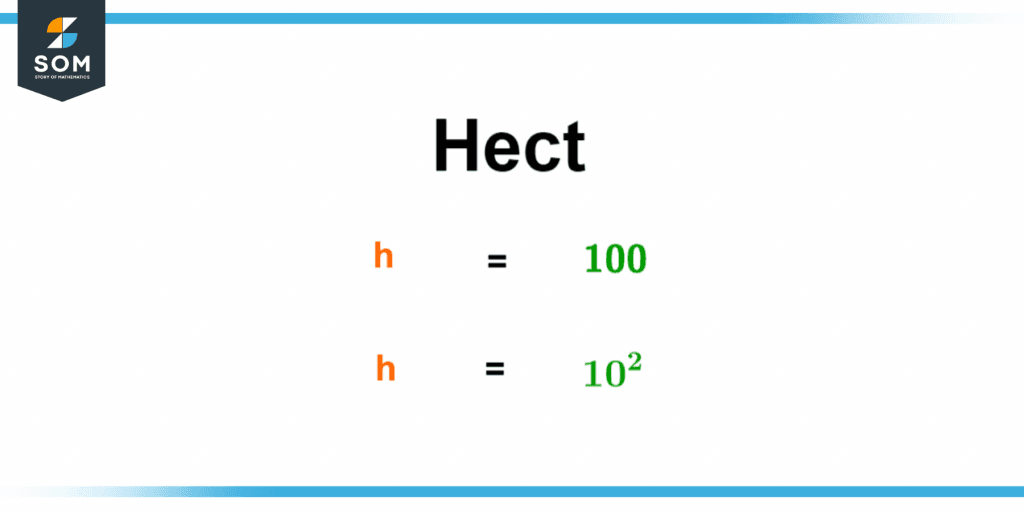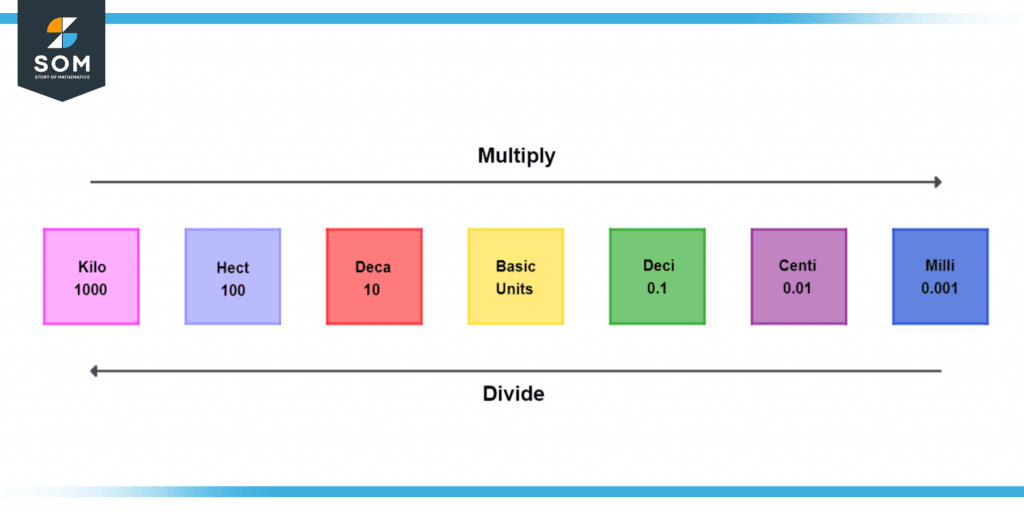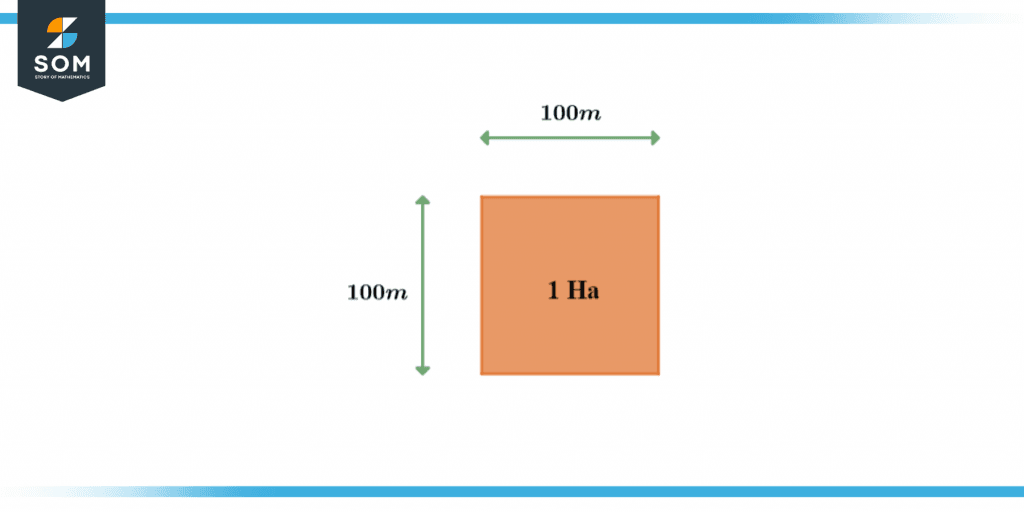JUMP TO TOPIC
Hect|Definition & Meaning
Definition
Hect is defined as the prefix we use to represent the number 100 when converting numbers in the metric system. It is represented by using ‘h.’
Explanation
The word Hect which is also known as “hecato” comes from a Greek word meaning hundred. It was adopted as a multiplier to be used in conversions. Hect is originally a prefix which has used in the metric system under the SI system. The SI system acts as a medium for conversions between different units.
The use of these systems allows us to communicate and share our calculations without having trouble due to different measuring units and languages. For this purpose, many prefixes were introduced just as hect.

Figure 1 – Value of Hect
Hect represents the number 100 when used in conversion, so to represent a number, we use:
h = 10$^2$
We use hect prefixes with other units to form larger units. Some of its examples are as given below:
1 hectogram = 100 grams
1 hectoliter = 100 liters
1 hectometer = 100 meters
Conversion of Hect
As we have discussed, hect represents 100 so in the metric system of prefixes under the International System of Units we have to follow some set of principles while converting the values.

Figure 2 – Metric Conversions using Prefixes
In the metric system when we need to move from a smaller value to a larger one we will divide it by the number or shift the decimal number from right to left. Whereas when we have to move to a smaller value we need to multiply the original value or shift the decimal point from right to left.
When converting from a value given in hect we will follow these protocols given for certain units:
Kilo
1 k = 10 h
So to convert from kilo to hecto we will multiply our value by 10 but if we want to move from hecto to kilo we will divide the value by 10.
Deka
1h = 10 da
So to convert from hecto to Deka we will multiply our value by 10 but if we want to move from Deka to hecto we will divide the value by 10.
Deci
1h = 1000 d
So to convert from hecto to deci we will multiply our value by 1000 but if we want to move from deci to hecto we will divide the value by 1000.
Uses of Hect
Hect represents the number 100. We use it in various fields to represent a big number of values. Some of the examples are as given below:
- A hectopascal is represented by hPa. It is used in meteorology for calculating atmospheric pressure. A millibar is considered it’s equivalent.
- Hectolitre is represented by either hl or hL. It is used in the agriculture sector to measure liquids in big amounts. These liquids might include milk, wine, vinegar, and some non-liquid material like grain.
- Hectogram is represented by hg. It is used in the livestock sector where the need of measuring the quantity of animal feed for better productivity calculations. It is also used to measure the sales of meat and cold cuts.
- The Hectometer is represented by hm. It is used in radio astronomy. We use it to describe the radio band and all the wavelengths that are produced.
- Hectare is represented by ha. It is also called a square hectometer.
100 acres = 1 hm$^2$ = 10,000 m$^2$

Figure 3 – Measurement of 1 hectare
Solved Examples of Hect
Example 1
Ronald wants to save the record of 50 kilolitres of milk collected from Australian cows on his farm in 1 day. Help him convert this amount into hectolitres so that it is easy for him to set up a progress report on the production of milk at his farm. Also, help him find 20 kilolitres of milk collected from goats to also add up in the final report.
Solution
To convert any value in kilo to hect we must multiply it by 10. This is because a kilo is represented by:
Kilo = 1000
Whereas hect is represented as:
Hect = 100
So for the milk produced by Australian cows at Ronald’s farm:
Cow Milk in hectolitre = 50 k × 10 h
Cow Milk in hectolitre = 500 hl
Now we will follow the same steps for goat milk:
Goat Milk in hectolitre = 20 k × 10 h
Goat Milk in hectolitre = 200 hl
Now to add the data for the final progress report:
Total milk produced = 200 hl + 500 hl
Total milk produced = 700 hl
Example 2
Is the word hect used in mathematics as a prefix under the SI system?
Solution
In the SI system prefixes are used before the actual quantities. Hect means 100 and it is used in numerous conversions. It is represented like this:
\[ h = 10^2 \]
It is a prefix hence some of its examples are as below:
Hectare ( Ha )
It represents the area of any object or land, like 100m sides of the land.
Hectolitre (hL)
It is used to represent volume in liters, like 100 liters of water.
Hectopascal (hPa)
It is used to represent pressure, like 100Pa of surface pressure
Hectometre (hm)
It is used to represent the length, like the 100m race of students.
Example 3
Convert 200 kilolitre to hectolitre.
Solution
We know that:
1 kilolitre = 1,000
1 h = 100
Now let’s first convert kilolitre to hectolitre. As we know, 1 kilolitre = 1,000, therefore:
200 kilolitre = 200 × 100 = 20,000 hL
Example 4
Nancy wants to convert 13.35 hectograms of grains into decigrams so that it is easy for her to divide and partition grains into small ration bags. Help her out with the conversion.
Solution
Nancy wants to convert grains from hectograms to decigrams. Here both the values are in grams which is a unit of mass.
The prefix “hecto” represents 100 under the SI system whereas the prefix “deci” represents 0.1 under this system. To understand the concept we can say that:
1 kg is equal to 10 hectograms ( kg = 1000 g )
1 kg is equal to 10000 decigrams, so we can say that 1 decigram is 0.001 times a hectogram.
Now:
13.35 hectogram = 13.35 × 1000
13.35 hectogram = 13350 decigram
Images/mathematical drawings are created with GeoGebra.
